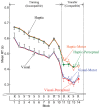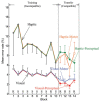The effect of haptic cues on motor and perceptual based implicit sequence learning
- PMID: 24734013
- PMCID: PMC3975096
- DOI: 10.3389/fnhum.2014.00130
The effect of haptic cues on motor and perceptual based implicit sequence learning
Abstract
We introduced haptic cues to the serial reaction time (SRT) sequence learning task alongside the standard visual cues to assess the relative contributions of visual and haptic stimuli to the formation of motor and perceptual memories. We used motorized keys to deliver brief pulse-like displacements to the resting fingers, expecting that the proximity and similarity of these cues to the subsequent response motor actions (finger-activated key-presses) would strengthen the motor memory trace in particular. We adopted the experimental protocol developed by Willingham (1999) to explore whether haptic cues contribute differently than visual cues to the balance of motor and perceptual learning. We found that sequence learning occurs with haptic stimuli as well as with visual stimuli and we found that irrespective of the stimuli (visual or haptic) the SRT task leads to a greater amount of motor learning than perceptual learning.
Keywords: haptic cue; motor memory; sequence learning; serial reaction time task.
Figures






Similar articles
-
The "Motor" in Implicit Motor Sequence Learning: A Foot-stepping Serial Reaction Time Task.J Vis Exp. 2018 May 3;(135):56483. doi: 10.3791/56483. J Vis Exp. 2018. PMID: 29781982 Free PMC article.
-
Persistent grasping errors produce depth cue reweighting in perception.Vision Res. 2021 Jan;178:1-11. doi: 10.1016/j.visres.2020.09.007. Epub 2020 Oct 15. Vision Res. 2021. PMID: 33070029
-
Predictive Movements and Human Reinforcement Learning of Sequential Action.Cogn Sci. 2018 Jun;42 Suppl 3(Suppl Suppl 3):783-808. doi: 10.1111/cogs.12599. Epub 2018 Mar 2. Cogn Sci. 2018. PMID: 29498434 Free PMC article.
-
Social Cues Alter Implicit Motor Learning in a Serial Reaction Time Task.Front Hum Neurosci. 2018 May 14;12:197. doi: 10.3389/fnhum.2018.00197. eCollection 2018. Front Hum Neurosci. 2018. PMID: 29867420 Free PMC article.
-
Planning lane changes using advance visual and haptic information.Psychol Res. 2024 Mar;88(2):363-378. doi: 10.1007/s00426-023-01879-9. Epub 2023 Oct 6. Psychol Res. 2024. PMID: 37801088
Cited by
-
Regular rhythmic and audio-visual stimulations enhance procedural learning of a perceptual-motor sequence in healthy adults: A pilot study.PLoS One. 2021 Nov 15;16(11):e0259081. doi: 10.1371/journal.pone.0259081. eCollection 2021. PLoS One. 2021. PMID: 34780497 Free PMC article.
-
An fMRI study on the generalization of motor learning after brain actuated supernumerary robot training.NPJ Sci Learn. 2024 Dec 30;9(1):80. doi: 10.1038/s41539-024-00294-y. NPJ Sci Learn. 2024. PMID: 39738213 Free PMC article.
References
-
- Armstrong T. (1970). Training for the Production of Memorized Movement Patterns. Technical Report. Ann Arbor, MI: Human Performance Center, University of Michigan
LinkOut - more resources
Full Text Sources
Other Literature Sources

